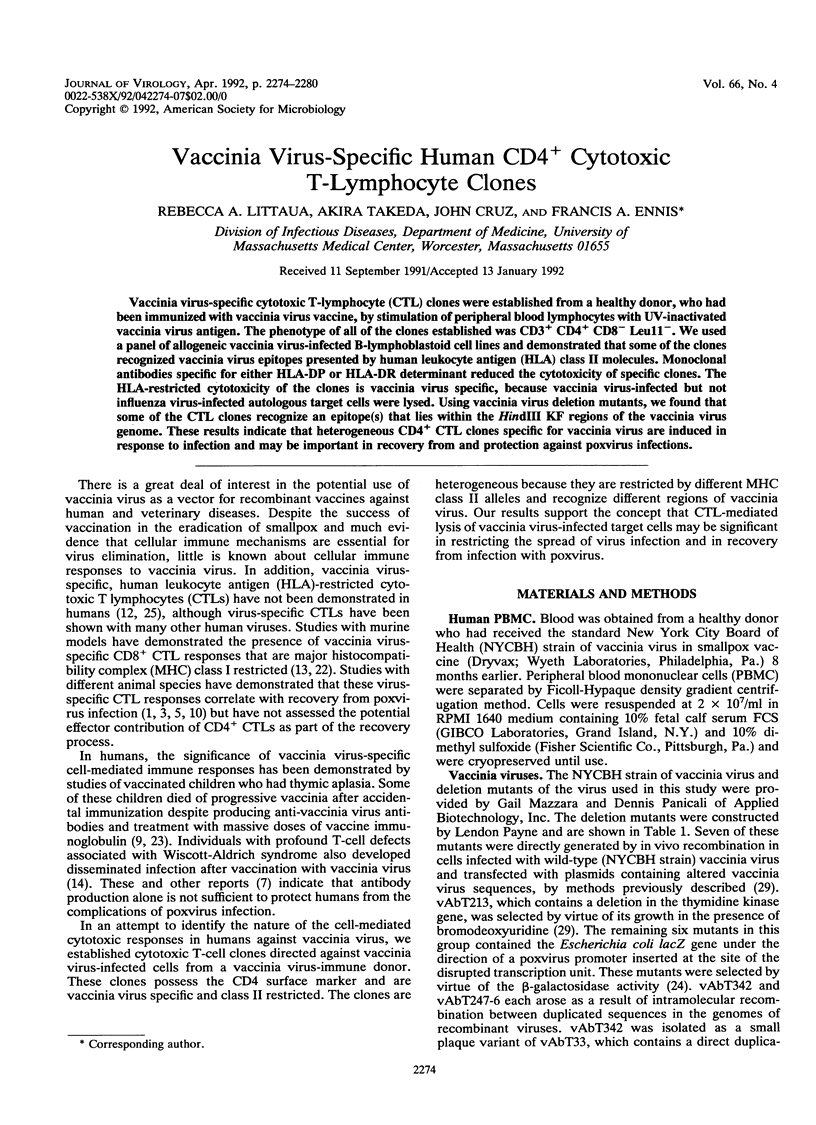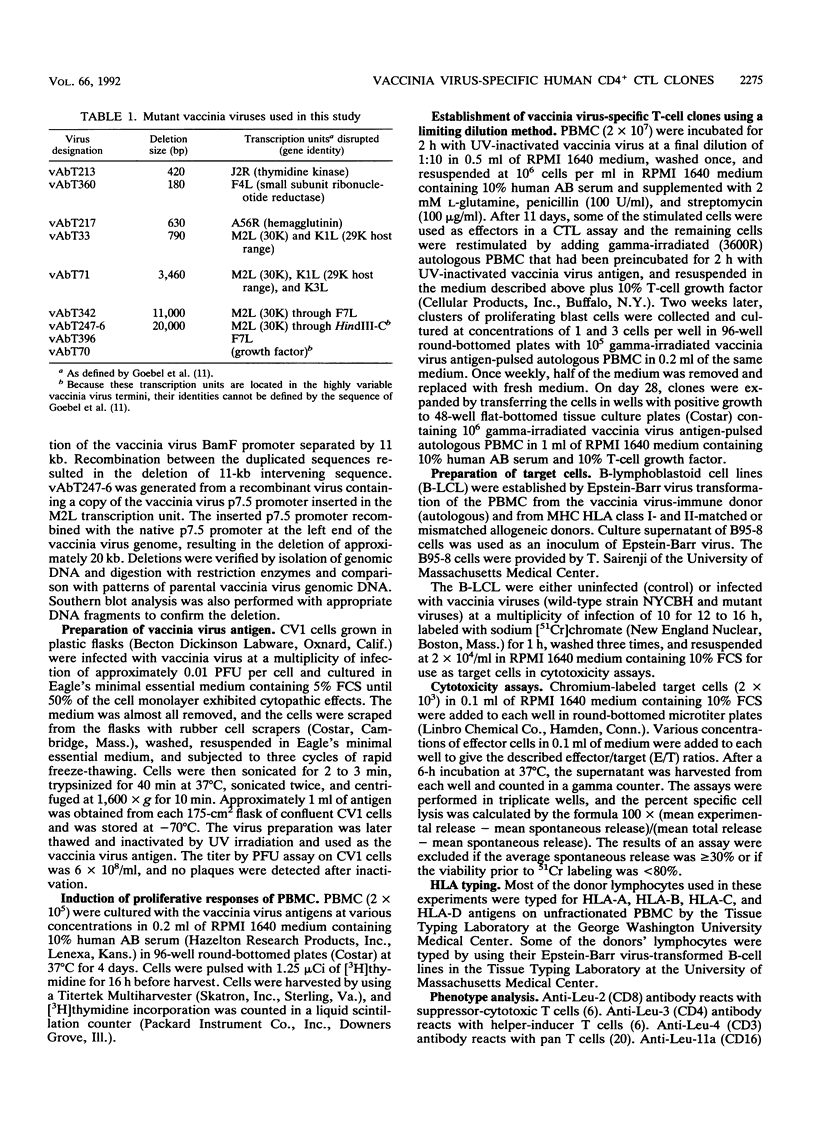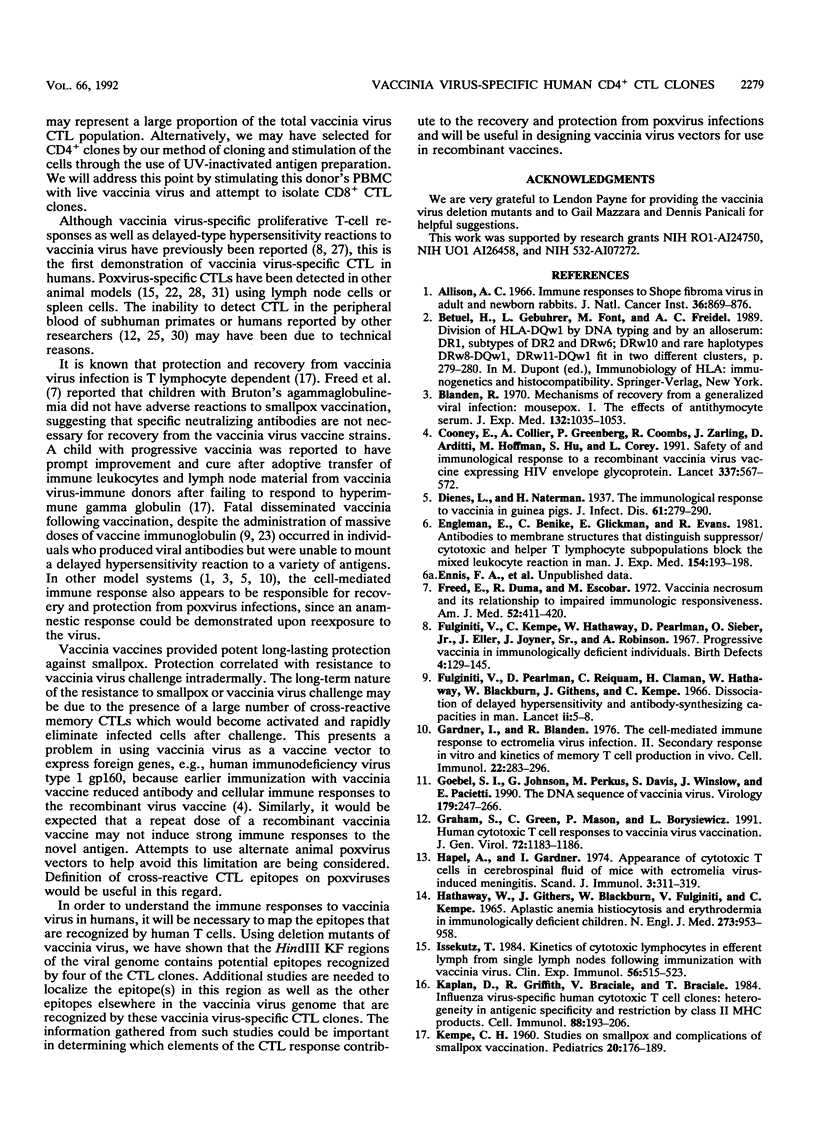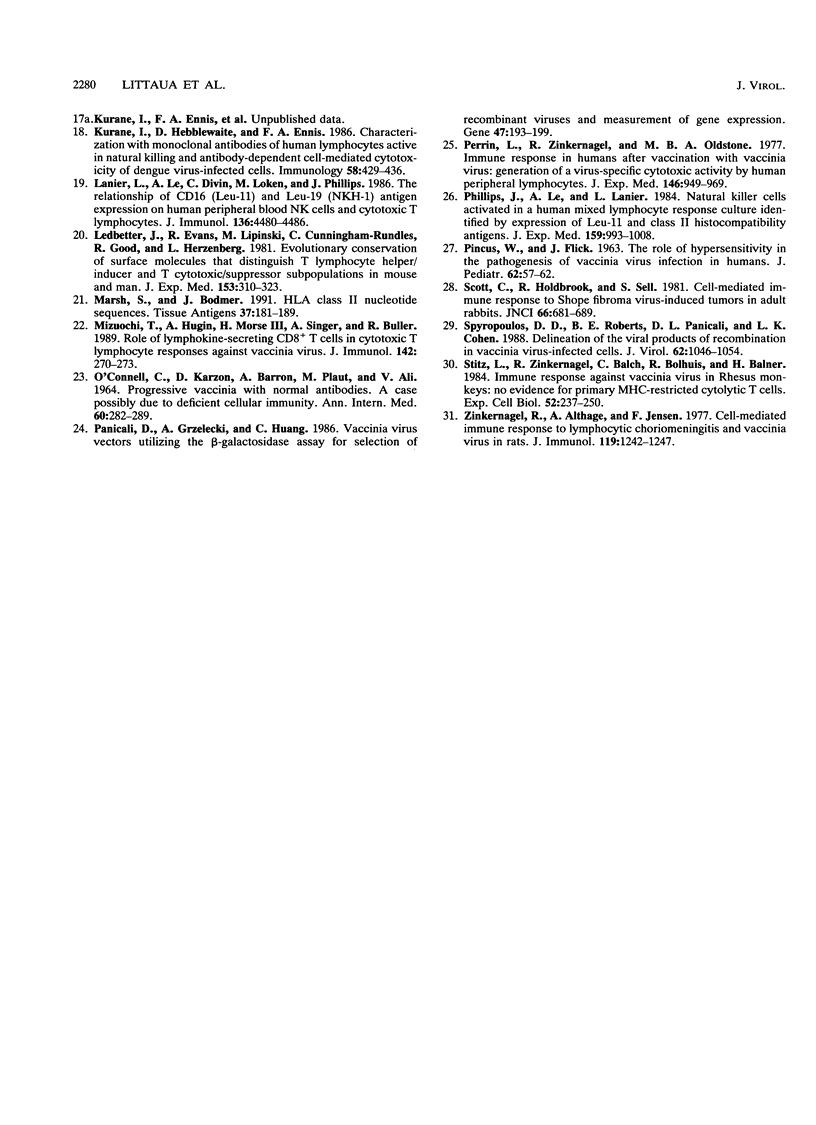Abstract
Vaccinia virus-specific cytotoxic T-lymphocyte (CTL) clones were established from a healthy donor, who had been immunized with vaccinia virus vaccine, by stimulation of peripheral blood lymphocytes with UV-inactivated vaccinia virus antigen. The phenotype of all of the clones established was CD3+ CD4+ CD8- Leu11-. We used a panel of allogenic vaccinia virus-infected B-lymphoblastoid cell lines and demonstrated that some of the clones recognized vaccinia virus epitopes presented by human leukocyte antigen (HLA) class II molecules. Monoclonal antibodies specific for either HLA-DP or HLA-DR determinant reduced the cytotoxicity of specific clones. The HLA-restricted cytotoxicity of the clones is vaccinia virus specific, because vaccinia virus-infected but not influenza virus-infected autologous target cells were lysed. Using vaccinia virus deletion mutants, we found that some of the CTL clones recognize an epitope(s) that lies within the HindIII KF regions of the vaccinia virus genome. These results indicate that heterogeneous CD4+ CTL clones specific for vaccinia virus are induced in response to infection and may be important in recovery from and protection against poxvirus infections.
Full text
PDF






Selected References
These references are in PubMed. This may not be the complete list of references from this article.
- Blanden R. V. Mechanisms of recovery from a generalized viral infection: mousepox. I. The effects of anti-thymocyte serum. J Exp Med. 1970 Nov;132(5):1035–1054. doi: 10.1084/jem.132.5.1035. [DOI] [PMC free article] [PubMed] [Google Scholar]
- Cooney E. L., Collier A. C., Greenberg P. D., Coombs R. W., Zarling J., Arditti D. E., Hoffman M. C., Hu S. L., Corey L. Safety of and immunological response to a recombinant vaccinia virus vaccine expressing HIV envelope glycoprotein. Lancet. 1991 Mar 9;337(8741):567–572. doi: 10.1016/0140-6736(91)91636-9. [DOI] [PubMed] [Google Scholar]
- Engleman E. G., Benike C. J., Glickman E., Evans R. L. Antibodies to membrane structures that distinguish suppressor/cytotoxic and helper T lymphocyte subpopulations block the mixed leukocyte reaction in man. J Exp Med. 1981 Jul 1;154(1):193–198. doi: 10.1084/jem.154.1.193. [DOI] [PMC free article] [PubMed] [Google Scholar]
- Freed E. R., Duma R. J., Escobar M. R. Vaccinia necrosum and its relationship to impaired immunologic responsiveness. Am J Med. 1972 Mar;52(3):411–420. doi: 10.1016/0002-9343(72)90031-9. [DOI] [PubMed] [Google Scholar]
- Fulginiti V. A., Hathaway W. E., Pearlman D. S., Blackburn W. R., Reiquam C. W., Githens J. H., Claman H. N., Kempe C. H. Dissociation of delayed-hypersensitivy and antibody-synthesising capacities in man. Report of two sibships with thymic dysplasia, lymphoid tissue depletion, and normal immunoglobulins. Lancet. 1966 Jul 2;2(7453):5–8. doi: 10.1016/s0140-6736(66)91742-9. [DOI] [PubMed] [Google Scholar]
- Gardner I. D., Blanden R. V. The cell-mediated immune response to ectromelia virus infection. II. Secondary response in vitro and kinetics of memory T cell production in vivo. Cell Immunol. 1976 Mar 15;22(2):283–296. doi: 10.1016/0008-8749(76)90030-7. [DOI] [PubMed] [Google Scholar]
- Goebel S. J., Johnson G. P., Perkus M. E., Davis S. W., Winslow J. P., Paoletti E. The complete DNA sequence of vaccinia virus. Virology. 1990 Nov;179(1):247-66, 517-63. doi: 10.1016/0042-6822(90)90294-2. [DOI] [PubMed] [Google Scholar]
- Graham S., Green C. P., Mason P. D., Borysiewicz L. K. Human cytotoxic T cell responses to vaccinia virus vaccination. J Gen Virol. 1991 May;72(Pt 5):1183–1186. doi: 10.1099/0022-1317-72-5-1183. [DOI] [PubMed] [Google Scholar]
- Hapel A., Gardner I. Appearance of cytotoxic T cells in cerebrospinal fluid of mice with ectromelia virus-induced meningitis. Scand J Immunol. 1974;3(3):311–319. doi: 10.1111/j.1365-3083.1974.tb01262.x. [DOI] [PubMed] [Google Scholar]
- Hathaway W. E., Githens J. H., Blackburn W. R., Fulginiti V., Kempe C. H. Aplastic anemia, histiocytosis and erythrodermia in immunologically deficient children. Probable human runt disease. N Engl J Med. 1965 Oct 28;273(18):953–958. doi: 10.1056/NEJM196510282731803. [DOI] [PubMed] [Google Scholar]
- Issekutz T. B. Kinetics of cytotoxic lymphocytes in efferent lymph from single lymph nodes following immunization with vaccinia virus. Clin Exp Immunol. 1984 Jun;56(3):515–523. [PMC free article] [PubMed] [Google Scholar]
- KEMPE C. H. Studies smallpox and complications of smallpox vaccination. Pediatrics. 1960 Aug;26:176–189. [PubMed] [Google Scholar]
- Kaplan D. R., Griffith R., Braciale V. L., Braciale T. J. Influenza virus-specific human cytotoxic T cell clones: heterogeneity in antigenic specificity and restriction by class II MHC products. Cell Immunol. 1984 Oct 1;88(1):193–206. doi: 10.1016/0008-8749(84)90064-9. [DOI] [PubMed] [Google Scholar]
- Kurane I., Hebblewaite D., Ennis F. A. Characterization with monoclonal antibodies of human lymphocytes active in natural killing and antibody-dependent cell-mediated cytotoxicity of dengue virus-infected cells. Immunology. 1986 Jul;58(3):429–436. [PMC free article] [PubMed] [Google Scholar]
- Lanier L. L., Le A. M., Civin C. I., Loken M. R., Phillips J. H. The relationship of CD16 (Leu-11) and Leu-19 (NKH-1) antigen expression on human peripheral blood NK cells and cytotoxic T lymphocytes. J Immunol. 1986 Jun 15;136(12):4480–4486. [PubMed] [Google Scholar]
- Ledbetter J. A., Evans R. L., Lipinski M., Cunningham-Rundles C., Good R. A., Herzenberg L. A. Evolutionary conservation of surface molecules that distinguish T lymphocyte helper/inducer and cytotoxic/suppressor subpopulations in mouse and man. J Exp Med. 1981 Feb 1;153(2):310–323. doi: 10.1084/jem.153.2.310. [DOI] [PMC free article] [PubMed] [Google Scholar]
- Marsh S. G., Bodmer J. G. HLA class II nucleotide sequences, 1991. Tissue Antigens. 1991 Apr;37(4):181–189. doi: 10.1111/j.1399-0039.1991.tb01870.x. [DOI] [PubMed] [Google Scholar]
- Mizuochi T., Hügin A. W., Morse H. C., 3rd, Singer A., Buller R. M. Role of lymphokine-secreting CD8+ T cells in cytotoxic T lymphocyte responses against vaccinia virus. J Immunol. 1989 Jan 1;142(1):270–273. [PubMed] [Google Scholar]
- O'CONNELL C. J., KARZON D. T., BARRON A. L., PLAUT M. E., ALI V. M. PROGRESSIVE VACCINIA WITH NORMAL ANTIBODIES. A CASE POSSIBLY DUE TO DEFICIENT CELLULAR IMMUNITY. Ann Intern Med. 1964 Feb;60:282–289. doi: 10.7326/0003-4819-60-2-282. [DOI] [PubMed] [Google Scholar]
- PINCUS W. B., FLICK J. A. The role of hypersensitivity in the pathogenesis of vaccinia virus infection in humans. J Pediatr. 1963 Jan;62:57–62. doi: 10.1016/s0022-3476(63)80071-2. [DOI] [PubMed] [Google Scholar]
- Panicali D., Grzelecki A., Huang C. Vaccinia virus vectors utilizing the beta-galactosidase assay for rapid selection of recombinant viruses and measurement of gene expression. Gene. 1986;47(2-3):193–199. doi: 10.1016/0378-1119(86)90063-6. [DOI] [PubMed] [Google Scholar]
- Perrin L. H., Zinkernagel R. M., Oldstone M. B. Immune response in humans after vaccination with vaccinia virus: generation of a virus-specific cytotoxic activity by human peripheral lymphocytes. J Exp Med. 1977 Oct 1;146(4):949–969. doi: 10.1084/jem.146.4.949. [DOI] [PMC free article] [PubMed] [Google Scholar]
- Phillips J. H., Le A. M., Lanier L. L. Natural killer cells activated in a human mixed lymphocyte response culture identified by expression of Leu-11 and class II histocompatibility antigens. J Exp Med. 1984 Apr 1;159(4):993–1008. doi: 10.1084/jem.159.4.993. [DOI] [PMC free article] [PubMed] [Google Scholar]
- Scott C. B., Holdbrook R., Sell S. Cell-mediated immune response to Shope fibroma virus-induced tumors in adult rabbits. J Natl Cancer Inst. 1981 Apr;66(4):681–689. [PubMed] [Google Scholar]
- Spyropoulos D. D., Roberts B. E., Panicali D. L., Cohen L. K. Delineation of the viral products of recombination in vaccinia virus-infected cells. J Virol. 1988 Mar;62(3):1046–1054. doi: 10.1128/jvi.62.3.1046-1054.1988. [DOI] [PMC free article] [PubMed] [Google Scholar]
- Stitz L., Zinkernagel R., Balch C. M., Bolhuis R. L., Balner H. Immune response against vaccinia virus in rhesus monkeys: no evidence for primary MHC-restricted cytolytic T cells. Exp Cell Biol. 1984;52(4):237–250. doi: 10.1159/000163267. [DOI] [PubMed] [Google Scholar]
- Zinkernagel R. M., Althage A., Jensen F. C. Cell-mediated immune response to lymphocytic choriomeningitis and vaccinia virus in rats. J Immunol. 1977 Oct;119(4):1242–1247. [PubMed] [Google Scholar]


